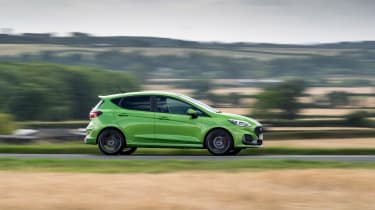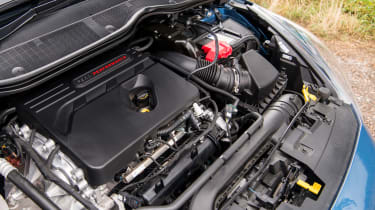Ford Fiesta ST review – engine, transmission and technical details
Responsive and tractable powertrain has its limits, but is fundamentally sound
Ford’s turbocharged 1.5-litre triple has had plenty of time to bed itself into the market, since proving itself to be an impressive unit that’s both powerful and flexible.
Being an EcoBoost unit, it has a wide spread of fuel-saving tech to keep it clean, including cylinder deactivation, which is rare on a three-cylinder engine. Cylinder one will shut down at low revs and low loads to the benefit of economy, firing back up in 14 milliseconds when more torque is required.
In numeric terms the ST develops the same power as when it was initially revealed, with peak power of 197bhp that puts it only a whisper behind the Hyundai i20 N’s 201bhp, and 214lb ft of torque.
The engine is an impressive unit, with a broad and flexible powerband that makes light work of the relatively low 1187kg kerb weight. It doesn’t quite have the top-end rush of the old 1.6-litre four-cylinder found in the previous-generation ST, but has more torque at low rpm to compensate.
To this three-pot Ford attaches a six-speed manual transmission, with standard fitment of a Quaife mechanical limited-slip differential to assist traction to the front wheels. STs feature both electronic sound generation inside the cabin and an active exhaust, and the behaviour of both varies depending on the driving mode (Normal, Sport and Track) selected.
In terms of its layout and structure the Fiesta ST uses much the same ingredients as other cars in this class, but throws a few herbs and spices into the mix to give the car its own flavour. Thus, you get a fairly conventional chassis set-up: steel monocoque with MacPherson strut front suspension and a torsion beam rear, with electrically assisted rack and pinion steering.
But you also get Ford’s patented ‘force vectoring springs’ – directionally wound and non-interchangeable coil springs – as an alternative to a Watt’s linkage. The aim is the same – improving lateral location of the axle – though the ability of the springs alone to apply vector forces to the suspension save the 10kg that Ford says a Watt’s linkage would add.
For now, Ford isn’t offering a redo of the excellent Edition model, which came with key hardware changes, replacing the standard springs and dampers with a set of manually adjustable coilovers that, from the factory, settled the body 15mm closer to the road. This was combined with a set of lighter flow-formed alloy wheels that made it the most dynamic of all STs.





